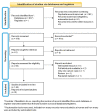Prevalence of Human Papilloma Virus Infection in Bladder Cancer: A Systematic Review
- PMID: 35885662
- PMCID: PMC9318826
- DOI: 10.3390/diagnostics12071759
Prevalence of Human Papilloma Virus Infection in Bladder Cancer: A Systematic Review
Abstract
The etiology of bladder cancer is known to be associated with behavioral and environmental factors. Moreover, several studies suggested a potential role of HPV infection in the pathogenesis with controversial results. A systematic review was conducted to assess the role of HPV. A total of 46 articles that reported the prevalence of HPV infection in squamous (SCC), urothelial (UC), and transitional cell carcinomas (TCC) were selected. A pooled prevalence of 19% was found, with a significant difference in SCC that was mainly driven by HPV-16. Moreover, infection prevalence in case-control studies showed a higher risk of bladder cancer in HPV-positive cases (OR: 7.84; p-value < 0.00001). The results may suggest an etiologic role of HPV in bladder cancer. HPV vaccine administration in both sexes could be key to prevent the infection caused by high-risk genotypes.
Keywords: HPV; HPV detection; bladder cancer; human papillomavirus; transitional cell carcinoma; urothelial carcinoma.
Conflict of interest statement
The authors declare no conflict of interest.
Figures



References
-
- International Agency for Reasearch on Cancer (IARC) Global Cancer Observatory. [(accessed on 18 May 2022)]. Available online: https://gco.iarc.fr.
-
- Prout G.R., Jr., Wesley M.N., Greenberg R.S., Chen V.W., Brown C.C., Miller A.W., Weinstein R.S., Robboy S.J., Haynes M.A., Blacklow R.S., et al. Bladder cancer: Race differences in extent of disease at diagnosis. Cancer. 2000;89:1349–1358. doi: 10.1002/1097-0142(20000915)89:6<1349::AID-CNCR20>3.0.CO;2-D. - DOI - PubMed
-
- Di Meo N.A., Loizzo D., Pandolfo S.D., Autorino R., Ferro M., Porta C., Stella A., Bizzoca C., Vincenti L., Crocetto F., et al. Metabolomic Approaches for Detection and Identification of Biomarkers and Altered Pathways in Bladder Cancer. Int. J. Mol. Sci. 2022;23:4173. doi: 10.3390/ijms23084173. - DOI - PMC - PubMed
Publication types
LinkOut - more resources
Full Text Sources
Research Materials

